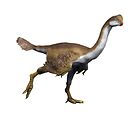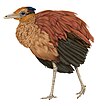細爪龍屬
| 細爪龍屬 | |
|---|---|

| |
| 細爪龍骨骼復原圖,遺失部位參考近緣物種 | |
| 科學分類 | |
| 界: | 動物界 Animalia |
| 門: | 脊索動物門 Chordata |
| 綱: | 蜥形綱 Sauropsida |
| 總目: | 恐龍總目 Dinosauria |
| 目: | 蜥臀目 Saurischia |
| 亞目: | 獸腳亞目 Theropoda |
| 科: | †傷齒龍科 Troodontidae |
| 亞科: | †傷齒龍亞科 Troodontinae |
| 屬: | †細爪龍屬 Stenonychosaurus Sternberg, 1932 |
| 模式種 | |
| †不等細爪龍 Stenonychosaurus inequalis Sternberg, 1932
| |
| 異名 | |
| |
細爪龍(屬名:Stenonychosaurus,意為「纖細爪子的蜥蜴」)是一屬傷齒龍科的獸腳類恐龍,生存於白堊紀晚期的北美洲,化石出土於加拿大亞伯達省的恐龍公園層、可能還有雙麥迪遜層。本屬經歷過極複雜的研究歷史。模式種兼唯一種不等細爪龍(S. inequalis)於1932年由查爾斯·斯騰伯格根據來自恐龍公園層的一隻腳、手部碎片以及一些尾椎的標本而描述、命名。1969年戴爾·羅素描述了來自同地點更完整的細爪龍骨骼,並為日後著名的還原比例模型及虛構的恐龍後代――恐人(Dinosauroid)奠定了科學基礎。[1]1980年代對腳部和腦殼的研究使得細爪龍廣為人知。1987年菲力·柯里將其重新歸類至原本依照可疑零碎標本而建立的傷齒龍屬,其後很長一段時間細爪龍都普遍被視為傷齒龍的異名。[2][3][4]直到2017年伊凡斯等人的研究才又將兩者分開,細爪龍恢復為獨立的屬,而傷齒龍則淪為疑名。[5]同年柯里等人的研究亦同意此觀點。[6]
發現歷史
[編輯]最早被歸入傷齒龍、不是只有牙齒的標本,是於1928年由查爾斯·斯騰伯格在亞伯達省恐龍公園層所發現。其中一個於1932年由斯騰伯格命名為不等細爪龍(Stenonychosaurus inequalis),正模標本(編號CMN 8539)是不完整的個體,主要包含六節尾椎、手部骨骼與近乎完整的右腳骨骼。其中,如今已知其右腳第二趾加大的趾爪是早期近鳥類的典型特徵。斯騰伯格最初將細爪龍分類至虛骨龍科[7]。第二個標本是部分下頜骨,於1932年由查爾斯·惠特尼·吉爾摩命名為一個蜥蜴的新種大多齒龍(Polyodontosaurus grandis)。後來於1951年斯騰伯格認為偉大多齒龍可能是傷齒龍的異名,並鑒於細爪龍有著「非常奇特的腳部」而傷齒龍有著「特別不尋常的牙齒」,推測兩者可能近緣。但礙於已知材料的稀缺,當時並沒有其他化石可供比較以支持這一論點。
除了正模標本,一些頭骨碎片標本也被鑑定為不等細爪龍,包含 UALVP 52611(一個幾乎完整的頭蓋骨)與 TMP 1986.036.0457(一個部分腦殼)。

1969年,戴爾·羅素描述了同樣來自恐龍公園、更完整的細爪龍骨骼。後來著名的1:1還原大小細爪龍雕像、以及衍生出的科幻產物—恐龍若未滅絕將演化出來的類人類—恐人(dinosauroid)的科學理論基礎,正是源自此研究。[1]
描述
[編輯]古生物學
[編輯]古生態學
[編輯]延伸閱讀
[編輯]參考來源
[編輯]- ^ 1.0 1.1 Russell, D. A.; Séguin, R. Reconstruction of the small Cretaceous theropod Stenonychosaurus inequalis and a hypothetical dinosauroid. Syllogeus. 1982, 37: 1–43.
- ^ Currie, P. Theropods of the Judith River Formation. Occasional Paper of the Tyrrell Museum of Palaeontology. 1987, 3: 52–60.
- ^ Paul, G.S. Predatory Dinosaurs of the World. New York: Simon and Schuster. 1988: 398–399. ISBN 978-0-671-61946-6.
- ^ Currie, P. (2005). "Theropods, including birds." in Currie and Koppelhus (eds). Dinosaur Provincial Park, a spectacular ecosystem revealed, Part Two, Flora and Fauna from the park. Indiana University Press, Bloomington. Pp 367–397.
- ^ Evans, D. C.; Cullen, T.M.; Larson, D.W.; Rego, A. A new species of troodontid theropod (Dinosauria: Maniraptora) from the Horseshoe Canyon Formation (Maastrichtian) of Alberta, Canada. Canadian Journal of Earth Sciences. 2017, 54 (8): 813–826 [2021-08-02]. Bibcode:2017CaJES..54..813E. doi:10.1139/cjes-2017-0034. (原始內容存檔於2021-12-18).
- ^ van see Reest, A. J.; Currie, P. J. Troodontids (Theropoda) from the Dinosaur Park Formation, Alberta, with a description of a unique new taxon: implications for deinonychosaur diversity in North America (PDF). Canadian Journal of Earth Sciences. 2017, 54 (9): 919–935. ISSN 1480-3313. doi:10.1139/cjes-2017-0031.
- ^ Sternberg, C. M. Two new theropod dinosaurs from the Belly River Formation of Alberta. The Canadian Field-Naturalist. 1932, 46: 99–105 [2021-09-19]. (原始內容存檔於2021-09-23).























